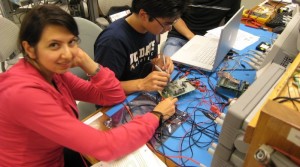 Dr. Tinoosh Mohsenin runs UMBC’s Engergy Efficient High Performance Computing Lab, where she works to develop highly accurate, low-power communication and healthcare devices.
Dr. Tinoosh Mohsenin runs UMBC’s Engergy Efficient High Performance Computing Lab, where she works to develop highly accurate, low-power communication and healthcare devices.
Dr. Tinoosh Mohsenin, associate professor, joined the Computer Science and Electrical Engineering faculty in January 2011. Since then, she has been running UMBC’s Energy Efficient High Performance Computing Lab, where she works with graduate students to develop highly accurate high performance systems—such as communication devices and medical equipment—that consume as little energy as possible.
Dr. Mohsenin became interested in energy efficient devices in 2002 when she worked as an intern at the Nokia Research Center. At Nokia, she was responsible for developing algorithms and architectures for cell phones and she realized then that battery dissipation was highly related to the efficient design of those architectures and algorithms. Since then, she has worked with several telecommunication and semiconductor companies as a consultant for their low power applications.
Currently, Dr. Mohsenin is pursuing three distinct projects in conjunction with her lab that fall within the realm of digital signal processing (DSP) and VLSI implementation. The first deals with many-core architectures for DSP and secured trusted platforms. The goal of the project is to design a reconfigurable, energy efficient and high performance many-core system which can dynamically reconfigure and execute algorithms in parallel with programmable speed/voltage settings to meet the application real time performance requirement. The project requires transformative architectural solutions for programmable processors and communication between them, application parallelization, software/hardware programming and chip implementation.
Dr. Mohsenin is also working on producing low-power processors for portable healthcare devices. She is working to produce real-time seizure detection and portable ultrasound devices that provide accurate analysis while requiring very little power. “The key goal for these projects is to improve healthcare comfort and cost for patients who do not want to be in hospitals,” explains Mohsenin. “This is specifically important for remote areas and battlefields, where there are not many hospitals with high-tech facilities.” Dr. Mohsenin’s ultrasound and seizure detection projects are part of the Telemedicine Initiative, the revolutionary incorporation of virtual healthcare analysis and treatment into the medical sphere.
 Lastly, Dr. Mohsenin is researching efficient error correction techniques for communications devices, such as cell phones and NASA satellite missions. “The key point for error correction at the receiving end is to remove the noises that came along with the transmitted data from the other side,” she explains. The goal of the project is to create novel decoding algorithms, architectures and circuits for near Shannon capacity for low-density parity-check (LDPC) decoders, she explains.
Lastly, Dr. Mohsenin is researching efficient error correction techniques for communications devices, such as cell phones and NASA satellite missions. “The key point for error correction at the receiving end is to remove the noises that came along with the transmitted data from the other side,” she explains. The goal of the project is to create novel decoding algorithms, architectures and circuits for near Shannon capacity for low-density parity-check (LDPC) decoders, she explains.
From energy efficient communication devices to wearable medical equipment, Dr. Mohsenin’s research projects aim to solve problems that affect us all. “Energy efficient and high performance computing has a large impact on our daily lives,” says Dr. Mohsenin. Today, cell phones are expected to do much more that make phone calls. “Nowadays cellphones have several functionalities including web browsing, games and multimedia, in addition to calling,” says Mohsenin. “All these functions must be performed in real time and within a limited phone battery budget.”
As for her work in the medical sphere, Dr. Mohsenin hopes to be able to significantly help with patients’ health, while reducing the cost. For example, neurological emergencies, such as status epilepticus and stroke, require urgent treatment within a limited time to reduce the risk of mortality or severe morbidity. Dr. Mohsenin’s telemedicine-based epilepsy project performs real time analysis and transmission of patient’s EEG data to a specialist center, which can allow for early diagnosis and treatment of the patients in order to save their lives and reduce resulting complications. By being able to detect health problems remotely, patients, especially those suffering from these time-sensitive ailments, are given a much higher chance of recovery.